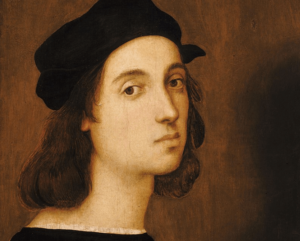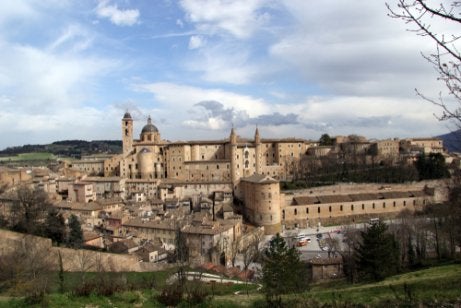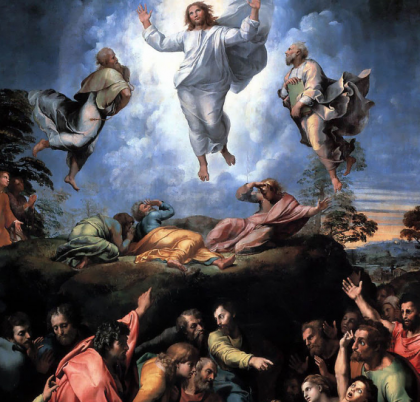Raphael Sanzio: Biography of a Renassaince Painter

Raphael is indisputably one of the greatest artists of the High Renaissance. He was a renowned painter and architect who gained the respect and admiration of his peers thanks to his Madonnas, portraits, frescos, and architectural compositions.
The Italian Renaissance artist was characterized by stylized figures and the development of perspective. It was a homage to Greco-Latin classics, an attempt to recover the beauty that Raphael believed had been lost during the Middle Ages. Some of the greatest artists in history emerged during the Renaissance.
Artists at that time were also scientists. Humanism is a movement that was alive and well at the time; a movement that brought together art, philosophy, and the sciences. Painters were expert observers of nature and could effectively portray the effects of light and shadow. Nature wasn’t the only subject matter, however. The artists of the Renaissance also observed the society around them.
Renaissance artists analyzed cultural interactions and got their inspiration from them. As a result, their lives were imbued with their research.
In this article, you’ll discover the factors that led to Raphael Sanzio becoming one of the most important artists of all time.
Raphael’s early years
Raphael Sanzio da Urbino was born on April 6, 1483, in Rinoello Sanzio, Urbino, Italy. At the time, Urbino was a culture center and a hotpot of artistic expression. Although Raphael’s family lost their fortune during the war, his father, Giovanni Santi, knew how to read and write. Santi was also the Urbino court painter.

Raphael didn’t know his mother well because she died young and his father quickly remarried. Raphael was considered a prodigy, so his father started to teach him at a young age about the principles of humanist philosophy in the court of the Duke of Urbino.
In 1494, when Raphael was 11 years old, his father died. That left Raphael to assume the difficult task of managing his father’s workshop. In spite of his age, he quickly became more successful than his father.
The city considered Raphael one of its greatest painters. When he was a teenager, they commissioned him to paint for San Nicola church in the neighboring town of Castello.
“Time is a vindictive bandit to steal the beauty of our former selves. We are left with sagging, rippled flesh and burning gums with empty sockets.”
-Raphael Sanzio-
Time in Perugia and the Florentine period
In 1500, a master painter named Pietro Vannunci, also known as Perugino, got in touch with Raphael. Perugino invited the young painter to join him in Perugia, the capital city of Umbria, to be his apprentice.
During his apprenticeship with Perugino, Raphael started to develop his own style. Sanzio was a lively young man who loved the city and its people. After working in Sienna, young Raphael went to Florence in 1504 with a recommendation from the Duchess of Urbino.
In Florence, the works of the most famous Italian painters of the time were a great inspiration for Raphael. Among them were Fra Bartolommeo, Leonardo da Vinci, Michelangelo, and Masaccio. Raphael considered these artists innovative painters who had achieved a completely new level of depth in their compositions.
“Leonardo da Vinci promises us heaven. Raphael gives it to us.”
-Pablo Picasso-
If you study his work in detail, you can see how much his time in Florence influenced his style. Under the tutelage of these great painters, Raphael developed a personal style that was even more expressive than that of his mentors. He didn’t live in Florence continuously but traveled to different cities in the northern part of Rome.
His stay in Rome, the art capital of the world
Raphael moved to Rome in 1508 to paint Le Stanze in the Vatican at the request of Pope Julius II.
Between 1509 and 1511, Sanzio worked on Le Stanze at the Vatican. It became one of the most well-respected fresco cycles of the Italian High Renaissance, especially those in the Stanza della Segnatura (“Room of the Signatura”).
This series of frescos include some of Raphael’s most famous pieces: The Triumph of Religion and The School of Athens. Here, Sanzio captured the humanist philosophy he learned in Urbino as a child.
While he was in Rome, Raphael was incredibly prolific. Inspired by his contemporaries and feeding off the artistic ambiance of the city, he reached the peak of his career as a painter.

Raphael and architecture
In 1514, after the death of architect Donato Bramante, Pope Julius II hired Raphael to be his main architect. In this role, Raphael created the chapel design at Sant’Eligio degli Orefici.
His paintings at the Vatican had made him famous, so he was able to hire a team of assistants to help him finish painting frescos in La Stanza dell’Incendio. Thus, he was able to focus on other projects.
Sanzio continued to accept commissions, including portraits of Popes Julius II and Leo X. In 1517, he also did his biggest painting on canvas, titled The Transfiguration.
While he was doing some painting, he dedicated most of his time to architecture. In fact, his architectural style was a foreshadowing of a burgeoning trend. His work was the beginning of the Baroque period.
Death and legacy of Raphael Sanzio
On April 6, 1520, when Raphael was just 37, he died suddenly of mysterious causes. It happened in Rome before he had the chance to finish his masterpiece, The Transfiguration. In the funeral mass at the Vatican, they placed the unfinished painting in front of his coffin.
At the time of his death, he had more than 50 apprentices working with him. But his workshop didn’t particularly interest the public. Instead, they speculated on what could’ve caused the painter’s untimely death.

Vasari, one of the first art historians, referred to Sanzio’s death as a “mysterious event”. Vasari blamed his death on an “excess of love“. While that might seem a silly hypothesis, no expert ever determined the true cause of his death.
Raphael left an impressive legacy. In addition, and less common for visual artists, society loved and appreciated him. His funeral was an impressive affair. Thousands of people showed up to honor his memory. Curiously, the renowned painter was born and died on Holy Friday. His body was buried in the Pantheon.
Stylistic legacy
His paintings possess a unique clarity in their composition and well-balanced elements. Sanzio is, without a doubt, the artist who brought mastery to perspective in a painting. After his death, Raphael’s movement towards mannerism influenced painting styles in the advanced Italian Baroque period.
In conclusion, Raphael Sanzio continues to be one of the main artistic figures of the Italian High Renaissance. The words on his tombstone read, “Here lies Raphael. In his life, great Mother Nature feared defeat. In his death, she herself feared to die”.
Raphael is indisputably one of the greatest artists of the High Renaissance. He was a renowned painter and architect who gained the respect and admiration of his peers thanks to his Madonnas, portraits, frescos, and architectural compositions.
The Italian Renaissance artist was characterized by stylized figures and the development of perspective. It was a homage to Greco-Latin classics, an attempt to recover the beauty that Raphael believed had been lost during the Middle Ages. Some of the greatest artists in history emerged during the Renaissance.
Artists at that time were also scientists. Humanism is a movement that was alive and well at the time; a movement that brought together art, philosophy, and the sciences. Painters were expert observers of nature and could effectively portray the effects of light and shadow. Nature wasn’t the only subject matter, however. The artists of the Renaissance also observed the society around them.
Renaissance artists analyzed cultural interactions and got their inspiration from them. As a result, their lives were imbued with their research.
In this article, you’ll discover the factors that led to Raphael Sanzio becoming one of the most important artists of all time.
Raphael’s early years
Raphael Sanzio da Urbino was born on April 6, 1483, in Rinoello Sanzio, Urbino, Italy. At the time, Urbino was a culture center and a hotpot of artistic expression. Although Raphael’s family lost their fortune during the war, his father, Giovanni Santi, knew how to read and write. Santi was also the Urbino court painter.

Raphael didn’t know his mother well because she died young and his father quickly remarried. Raphael was considered a prodigy, so his father started to teach him at a young age about the principles of humanist philosophy in the court of the Duke of Urbino.
In 1494, when Raphael was 11 years old, his father died. That left Raphael to assume the difficult task of managing his father’s workshop. In spite of his age, he quickly became more successful than his father.
The city considered Raphael one of its greatest painters. When he was a teenager, they commissioned him to paint for San Nicola church in the neighboring town of Castello.
“Time is a vindictive bandit to steal the beauty of our former selves. We are left with sagging, rippled flesh and burning gums with empty sockets.”
-Raphael Sanzio-
Time in Perugia and the Florentine period
In 1500, a master painter named Pietro Vannunci, also known as Perugino, got in touch with Raphael. Perugino invited the young painter to join him in Perugia, the capital city of Umbria, to be his apprentice.
During his apprenticeship with Perugino, Raphael started to develop his own style. Sanzio was a lively young man who loved the city and its people. After working in Sienna, young Raphael went to Florence in 1504 with a recommendation from the Duchess of Urbino.
In Florence, the works of the most famous Italian painters of the time were a great inspiration for Raphael. Among them were Fra Bartolommeo, Leonardo da Vinci, Michelangelo, and Masaccio. Raphael considered these artists innovative painters who had achieved a completely new level of depth in their compositions.
“Leonardo da Vinci promises us heaven. Raphael gives it to us.”
-Pablo Picasso-
If you study his work in detail, you can see how much his time in Florence influenced his style. Under the tutelage of these great painters, Raphael developed a personal style that was even more expressive than that of his mentors. He didn’t live in Florence continuously but traveled to different cities in the northern part of Rome.
His stay in Rome, the art capital of the world
Raphael moved to Rome in 1508 to paint Le Stanze in the Vatican at the request of Pope Julius II.
Between 1509 and 1511, Sanzio worked on Le Stanze at the Vatican. It became one of the most well-respected fresco cycles of the Italian High Renaissance, especially those in the Stanza della Segnatura (“Room of the Signatura”).
This series of frescos include some of Raphael’s most famous pieces: The Triumph of Religion and The School of Athens. Here, Sanzio captured the humanist philosophy he learned in Urbino as a child.
While he was in Rome, Raphael was incredibly prolific. Inspired by his contemporaries and feeding off the artistic ambiance of the city, he reached the peak of his career as a painter.

Raphael and architecture
In 1514, after the death of architect Donato Bramante, Pope Julius II hired Raphael to be his main architect. In this role, Raphael created the chapel design at Sant’Eligio degli Orefici.
His paintings at the Vatican had made him famous, so he was able to hire a team of assistants to help him finish painting frescos in La Stanza dell’Incendio. Thus, he was able to focus on other projects.
Sanzio continued to accept commissions, including portraits of Popes Julius II and Leo X. In 1517, he also did his biggest painting on canvas, titled The Transfiguration.
While he was doing some painting, he dedicated most of his time to architecture. In fact, his architectural style was a foreshadowing of a burgeoning trend. His work was the beginning of the Baroque period.
Death and legacy of Raphael Sanzio
On April 6, 1520, when Raphael was just 37, he died suddenly of mysterious causes. It happened in Rome before he had the chance to finish his masterpiece, The Transfiguration. In the funeral mass at the Vatican, they placed the unfinished painting in front of his coffin.
At the time of his death, he had more than 50 apprentices working with him. But his workshop didn’t particularly interest the public. Instead, they speculated on what could’ve caused the painter’s untimely death.

Vasari, one of the first art historians, referred to Sanzio’s death as a “mysterious event”. Vasari blamed his death on an “excess of love“. While that might seem a silly hypothesis, no expert ever determined the true cause of his death.
Raphael left an impressive legacy. In addition, and less common for visual artists, society loved and appreciated him. His funeral was an impressive affair. Thousands of people showed up to honor his memory. Curiously, the renowned painter was born and died on Holy Friday. His body was buried in the Pantheon.
Stylistic legacy
His paintings possess a unique clarity in their composition and well-balanced elements. Sanzio is, without a doubt, the artist who brought mastery to perspective in a painting. After his death, Raphael’s movement towards mannerism influenced painting styles in the advanced Italian Baroque period.
In conclusion, Raphael Sanzio continues to be one of the main artistic figures of the Italian High Renaissance. The words on his tombstone read, “Here lies Raphael. In his life, great Mother Nature feared defeat. In his death, she herself feared to die”.
This text is provided for informational purposes only and does not replace consultation with a professional. If in doubt, consult your specialist.







